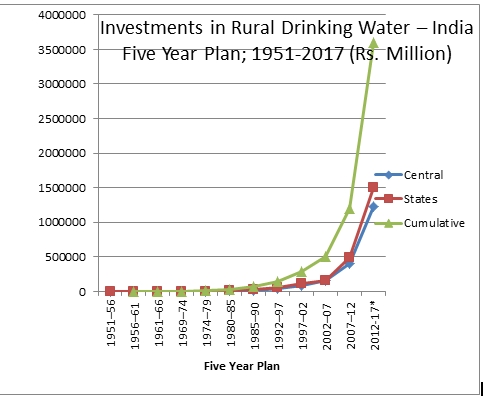"Everyone forever" may be ahead of schedule in India, but where is the will to achieve it?
Published on: 21/10/2013
In India, water for all is an eluding shadow. When a promise slips, goal posts are shifted to create a new target. With 90% (Census 2011) coverage, good policies and huge resources, India is truly on the threshold of achieving "everyone forever" [1]. Political will to link policies and practice to improve sector management can catapult India to the orbit of sustainable service delivery.
The government is targeting universal, sustainable and inclusive coverage by 2022. Is it too ambitious?
The Government of India (GoI), drinking water supply strategy plan 2010-2022 [2] sets out the target that every rural person in the country will have access to 70 litres per capita per day (lpcd ) within or near their premises by 2022. By 2017, at least 55% of rural households are to be provided with piped water supply. The plan also calls for a shift in focus from construction to service delivery. In other words, the GoI is targeting universal, sustainable and inclusive coverage by 2022. Is it too ambitious? A critical look at the sector resource base of India shows that "everyone forever" is possibly ahead of schedule. What is lacking is the will to achieve it.
India has sound policies and a large-impact National Rural Drinking Water Programme (NRDWP). The country has emerged as a leading investor in rural water supply and sanitation (RWSS), with a cumulative post-independence investment to the tune of over US$ 30 billion and an annual average investment of US$ 4 billion in recent years, as shown in figure 1.

Fig. 1 Investments in rural drinking water in India
Fig. 1 also shows an almost vertical quantum jump in outlay proposed under the 12th Five Year Plan 2012-17 to the tune of INR 2,724 billion - 3,032 billion (US$ 43.5 billion - 48.5 billion) [3]. Over and above, there are other significant additional funding streams like the Finance Commission grants, external borrowing, donor support and household investments that are crowding in to compensate for the inefficiency of public service delivery. The sector also has a huge cost recovery potential for improved and reliable services and an almost 40% scope for efficiency improvement.
While sector investments are impressive, service delivery is failing, drinking water supply systems are unsustainable and outcomes poor. On average, 30-35% of the schemes are dysfunctional, yet another 30% are functioning sub-optimally leading to a high rate of slippage and poor service levels. As per the 2011 census, handpumps continue to be the single largest source of water in the rural areas (44%), which are unreliable, only 32% of the households use treated piped water (as against over 75% in Brazil and China) and 18% still fetch drinking water from a source located away from their premises. Deteriorating water quality, unsustainability of sources, weak institutions, poor coordination and convergence, an abysmally low rate of cost recovery, high non-revenue water (35-40%), inequity and exclusion all pose a serious threat to India’s drinking water security. India is in the sandwiched middle to tackle simultaneously the challenges of last mile coverage and maintenance of languishing massive assets created.
Undoubtedly, India needs to extricate itself from the ‘’high investment-low outcome’’ trap, adopting an approach of sustainable service delivery and by dismantling barriers in accountability. Achieving water services that last for everyone is within India’s reach in the medium term, if backed by political will with the right mix of change management.
Accordingly the 12th Five Year (2012-17) needs priority action on six critical areas:
Lagging states with low level of services are in a way ideal for a new beginning. Our generation deserves the basic right to have adequate clean drinking water. With all its resources, who will forgive India if it decides to follow the deliberate strategy of "misery by choice"?
At IRC we have strong opinions and we value honest and frank discussion, so you won't be surprised to hear that not all the opinions on this site represent our official policy.